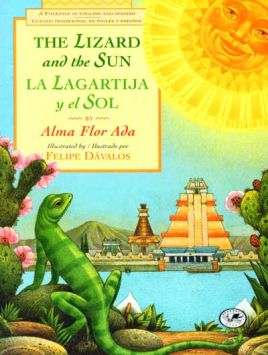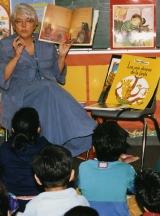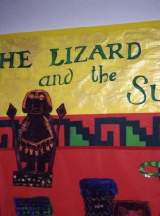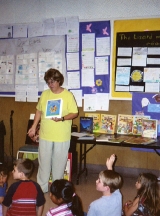The Lizard and the Sun / La lagartija y el sol
A Mexican Folktale in a Bilingual Format
RECOGNITION
Gold Medal, Folklore Category, NAPPA – National Parenting Publications Association
BOOK DESCRIPTION
Once, a long, long time ago, the sun disappeared from the sky. Everything was dark for many days. All the animals went to search for the sun in the rivers and lakes, through the fields and forests, but the sun was nowhere to be found. Little by little all the animals gave up, except for the faithful lizard. Finally one day she found a strange glowing rock and discovered the sun fast asleep. But no one could persuade the sun to wake up. Then the emperor organized a great feast, with the finest dancers and musicians, so the sun would wake up and never fall asleep again. Since that day, all lizards love to lie in the sun, to remember the day when one of their own brought light and warmth back to the world.
AUTHOR’S NOTE
What a gift to have had Felipe Dávalos create the art for this story! Felipe Dávalos is a great artist and also a learned scholar. As an archaeologist he knows a great deal about the time and setting of this story. And his wonderful illustrations reflect his art and his knowledge.
REVIEWS
School Library Journal
Kindergarten-Grade 3: A bilingual (English/Spanish) retelling of a Mexican folktale. When the sun does not appear for several days in a row, everyone becomes anxious. Various animals set off to look for it in such places as rivers, lakes, the jungle, and even in the cone of a volcano. After searching high and low, they give up, except for Lizard. Her faith and perseverance is rewarded when the celestial body is found sleeping under a rock. The story emphasizes the importance of the sun to all living creatures. The colorful double-page illustrations evoke the native culture by featuring characters in their decorated tunics and headdresses. In addition, the use of musical instruments such as drums reinforces Indian culture. Readers will cheer Lizard as she finds the Earth’s source of light and warmth. An excellent choice for storyhours. –Vianela Rivas, NYPL.
Kirkus Reviews
Ada (Mediopollito/Half-Chicken, 1995, etc.) elongates a Mexican folktale about a tenacious lizard who won’t stop looking for the sun when it disappears; Dávalos creates a series of half-lit, blue-toned spreads that evoke the world of the Aztec empire. A first-person introduction explains natural absences of the sun (behind the clouds, etc.), and prepares readers for a time, long ago, when the sun disappeared for no reason. Animals and birds search for it, and fail; only the lizard continues, finding a strangely glowing rock and rushing off to the city to tell the emperor. He tells her to move the rock, which she attempts, but the rock won’t budge–once more, she’s off to the city. The emperor comes to the rock with a woodpecker, and its beak splits the rock open, revealing a sleeping sun, who drowsily agrees to return to the sky if the emperor will provide the liveliest musicians and dancers. So the entertainment is arranged, and all ends well, with the inauguration of an annual feast. English and Spanish texts appear on each spread of this pleasant tale, diluted only by the several journeys of the lizard between rock and city, and the sun’s prolonged resistance to waking up. (Picture book/folklore. 5-8).
Center of Children’s Books
“Once in ancient Mexico, the sun disappeared. For days the anxious people wait for the sun to return, but it does not. When lizard discovers a rock lowing with an inner light, she tells the emperor and they awaken the sleeping sun; it returns to the sky, shedding light and warmth on all the earth. Ada retells this traditional tale with graceful language and read aloud rhythms, juxtaposing images of the tenacious, questing lizard against the darkness of jungle, marketplace, and palace. Dávalos paintings are rich with color and expression as the bright green lizard traverses the torchlit night in balanced compositions that spring to bright life with the discovery of the brilliant, sleeping sun. […]” (The Bulletin for the Center of Children’s books. October, 1997)
Bookpage
“[…] The Cuban-born author says she hopes the dual-language format will help awaken children’s interest in acquiring a second language, and certainly it should arouse their curiosity. Artist Felipe Dávalos, originally from Mexico, has created a colorful, exotic landscape full of pyramids, cacti and ancient Mexican sculpture and design. His illustrations beautifully capture the glowing changes as the sun shines once more. “The Lizard and the Sun” is a sumptuous introduction to the land of the Aztec and Maya.” (Bookpage. October, 1997)
The Reading Teacher
“[. . .] Felipe Dávalos’s stylized double-page illustrations complement the bilingual text handsomely. Cross-hatching and speckled backgrounds add shading and texture to artfully arranged compositions that echo the city’s pyramid shapes.” (Reading Teacher, September 1998)
School Library Journal
“A bilingual (English/Spanish) retelling of a Mexican folktale. When the sun does not appear for several days in a row, everyone becomes anxious. Various animals set off to look for it in such places as rivers, lakes, the jungle, and even in the cone of a volcano. After searching high and low, they give up, except for Lizard. Her faith and perseverance is rewarded when the celestial body is found sleeping under a rock. The story emphasizes the importance of the sun to all living creatures. The colorful double-page illustrations evoke the native culture by featuring characters in their decorated tunics and headdresses. In addition, the use of musical instruments such as drums reinforces Indian culture. Readers will cheer Lizard as she finds the earth’s source of light and warmth. An excellent choice for story hours.” (Vanesa Rivas, NYPL, School Library Journal, August, 1997)
Booklist
“Presented in both Spanish and English, this gentle traditional tale from Mexico shows how people working together can get the job done. When the sun disappears from the sky it is lizard who discovers “a rock that is shining as though it had a light inside.” Traveling to the distant city she tells the emperor who orders her to move it. But when is unable to, the emperor and the woodpecker help lizard release the reluctant sun trapped inside. The structure is different from many folktales, allowing more room for Ada’s eloquent voice. Dávalos sets the story during the time of the Aztec empire; his stylistically detailed artwork is initially veiled in midnight blue but erupts in golden yellow when the sun finally returns to the sky. According to the author’s note, Ada remembers this pourquoi story from an old reading text.” (Julie Corsaro, Booklist, December, 1997).
MINI LESSON TO PRESENT THIS BOOK:
THE LIZARD AND THE SUN
by Alma Flor Ada
The Story
This ancient legend takes place when the city of Tenochtitlán was one of the largest in the world. It tells how a little green lizard by not giving up was able to save the world from disappearing in the shadows. The outstanding illustrations by Felipe Dávalos allow us to participate in the daily life and the magnificence of the great Inca empire.
How This Book Was Created
The major civilizations of the Americas have been for me a constant source of admiration and pride. Among its many legends I was always fascinated by the lizard who would not give up, because it reflects so well an important saying that has guided my life, a sayings that has led Latinos searching for development: ¡Sí se puede! Yes, we can! I grew up in contact with nature and was always delighted by lizards, very abundant in my home land. As a young child I would collect their eggs and placed them on a planter, watching them for hours in the hope of seeing them hatch. The little lizards never came out during my watch, so I had to be content seeing the empty crumbled shells. It is a great joy for me that Maestro Felipe Dávalos would share in the creation of this story. Due to his background in archaeology and his deep knowledge of the period of this story, Felipe Dávalos was able to recreate this world both with great authenticity and artistic originality.
Themes, Concepts and Values
- life in the Aztec Empire
- the city of Tenochtitlán
- music
- perseverance or tenacity
- the importante of not living up
Vocabulary
- animals: jaguar, eagle, hare, deer, frog, toad, woodpecker
- places: pond, field, lake, jungle, mountain, volcano, desert
- concepts: empire, palace, throne, emperor
- values: constancy, perseverance, tenacity
Cultural Enrichment
The great city of Tenochtitlán, capital of the Inca Empire was one of the largest and most important cities of its time. Built over a lake it had ample bridges, beautiful palaces and magnificent temples. Much of the transportation was done with canoes. In its extraordinary market place one could find a great diversity of products, produce and handcrafted item. The Aztecs, like many of the indigenous people of the Americas, gave homage to the Sun and celebrate great festivities in its honor.
To Introduce The Book
If you turn off all lights and place several lighted candles, the students will be able to have an experience similar to the one described in the book. Later they will be able to discuss their experience and contrast it with those in the legend.
Previous Knowledge and Experiences
Talk about these contrasts. The students’ comments will vary. You may want to write them down.
- Light: Advantages = One can see
- Light: Disadvantages = One cannot see
- Darkness: Advantages = One can rest
- Darkness: Disadvantages = One may trip
Invite the students to share what they already know about the Aztec Empire. Here are some examples of possible answers. Write the ones the students offer.
Aztec Empire:
Where? Ancient México
When? In the XV Century
How? Daily life: They cultivated corn and cacao. Government: They had an emperor and several castes. Education: There was a school for young men, the “Calmecac.”
Encourage them also to share their ideas and feelings about the topic.
Creative Dialogue
These questions, or similar ones, will facilitate a true dialogue between the reader and the text. In this way the reading will not only enrich the students with new visions and ideas, but will allow them to recognize themselves as protagonists in their own lives.
Descriptive Phase. To facilitate comprehension of the text.
- Why were the persons worried when the sun disappeared?
- Which were some of the animals that search for the sun?
- Why did they give up?
Personal Interpretive Phase. To relate the text to personal experiences. These comparisons may validate personal experiences or enrich them, they can corroborate the text or compliment it.
- Have you ever faced a difficulty? Were you able to resolve it?
- Have you seen anyone solve a difficult problem? How?
- Do you know anyone who did not give up in the face of adversity?
- What in your life is so important you would never give it up or you will be persistent to preserve it?
Crítical/Multicultural Phase. To stimulate reflection against discrimination, racism, prejudism or inequality and in favor of social justice and peace.
- Do you believe it is important to not give up? Why?
- Do you believe Latinos have shown tenacity in this country? How?
Creative/Transformative Phase. To analyze the readers’ own reality, enriched and strengthened by the dialogue, in order to make decisions for future actions in pro of justice, equality and peace.
The sun gives light and warmth and permits life. What can you do to improve your own life? To improve your home environment?
The Sun gives joy. When the sun shines the birds sing and children play. What can you do to bring joy to others?
Literatura en acción:
LA LAGARTIJA Y EL SOL
por Alma Flor Ada
La historia
Esta antigua leyenda, que ocurre cuando la ciudad de Tenochtitlán era una de las más grandes del mundo, relata como una pequeña lagartija verde que no se dio por vencida logró salvar al mundo de desaparecer en la oscuridad. Las extraordinarias ilustraciones de Felipe Dávalos nos permiten participar de la vida diaria y de la magnificencia del gran imperio azteca.
Cómo se creó este libro
Las grandes civilizaciones de América son, para mí, constante motivo de admiración y orgullo. Entre sus muchas leyendas me fascinó siempre la de la lagartijita que no se dio por vencida, porque refleja tan bien el importante dicho popular que ha regido mi vida y que ha servido de lema a los hispánicos que buscan la superación: ¡Sí se puede!. Como crecí en contacto con la naturaleza, siempre me encantaron las lagartijas que son muy abundantes en mi tierra. De niña recogía sus huevecitos y los reunía en una maceta y los observaba por horas, soñando ver aparecer las lagartijitas. Pero jamás se decidieron a salir en mi presencia, y tenía que contentarme sólo con ver los cascaroncitos vacíos. Es una alegría inmensa para mí que el Maestro Felipe Dávalos compartiera la creación de este libro. Por su formación como arqueólogo y su profundo conocimiento de esta realidad, Felipe Dávalos pudo recrear este mundo con toda exactitud a la vez que con su usual genialidad artística.
Temas, conceptos y valores
- la vida en el Imperio azteca
- la ciudad de Tenochtitlán
- la música
- la perseverancia o tenacidad
- la importancia de no darse por vencido
Vocabulario
- animales: jaguar, águila, liebres, venados, ranas, sapos, pájaro carpintero
- lugares: prados, lagunas, charcos, selva, montañas, volcanes, desierto
- conceptos: imperio, palacio, trono, emperador
- valores: constancia, perseverancia, tenacidad
Enriquecimiento cultural
La gran ciudad de Tenochtitlán, capital del Imperio Azteca, era una de las mayores y más importantes ciudades de su tiempo. Construida sobre una laguna, tenía amplios puentes, hermosos palacios y templos extraordinarios. Mucha de la comunicación se hacía en canoas. En su enorme mercado se encontraba una gran diversidad de productos alimenticios y artesanales. Los aztecas, como muchos de los pueblos indígenas de América, rendían culto al sol y hacían grandes festividades en su honor.
Para presentar este libro
Si apaga todas las luces y coloca varias velas encendidas permitirá que los alumnos tengan una experiencia similar a la descrita en el libro. Luego podrán comparar sus experiencias.
Conocimientos y experiencias previas : Conversen sobre estos contrastes. Las respuestas variarán. Anótelas.
Contrastes:
- Luz: Utilidades = Se puede ver
- Luz: Desventajas = No se puede dormir
- Obscuridad: Utilidades = Permite descansar
- Obscuridad: Desventajas = Uno puede tropezarse
Invítelos a compartir lo que sepan sobre el imperio azteca. Aquí hay algunos ejemplos de respuestas posibles. Anote las que den los alumnos.
El imperio azteca:
¿Dónde? En el antiguo México
¿Cuándo? En el siglo XV
¿Cómo?
Vida diaria: Cultivaban el cacao
El gobierno: Tenían un emperador y distintas castas
La educación: Tenían una escuela para jóvenes llamada “El Calmecac”
Anímelos a expresar también sus ideas y sentimientos sobre el tema.
Diálogo Creador
Estas preguntas u otras similares facilitarán un verdadero diálogo entre el texto y el lector. Así la lectura no sólo enriquecerá a los niños con nuevas visiones e ideas, sino les ayudará a reconocerse a sí mismos como protagonistas de su propia vida.
Fase descriptiva — Para facilitar la comprensión de la lectura
- ¿Por qué estaban preocupadas las personas cuando el sol desapareció?
- ¿Cuáles fueran algunos de los animales que lo buscaron?
- ¿Por qué se dieron por vencidos?
Fase interpretativa personal — Para relacionar el texto a las experiencias personales. Estas comparaciones pueden validar las experiencias personales o enriquecerlas, pueden corrobar el texto o complementarlo.
- ¿Te has enfrentado alguna vez a un problema difícil? ¿Pudiste resolverlo?
- ¿Has visto a alguien resolver un problema difícil alguna vez? ¿Cómo lo hizo?
- ¿Conoces a alguien que no se da por vencido¿ ¿n qué ha perseverado esa persona?
Fase crítica/Multicultural — Para estimular la reflexión crítica en contra de la discriminación o los prejuicios y en favor de la justicia social y la paz.
- ¿Crees que la perseverancia es importante¿ ¿Por qué?
- ¿En qué forma crees que los hispánicos hemos perseverado en este país?
Fase creadora / transformadora – Para analizar al mundo real de los lectores, enriquecidos y fortalecidos y tomar determinaciones para acciones futuras en pro de la justicia, el bien y la paz.
El sol da luz y calor y permite la vida. ¿Qué puedes hacer tú para que tu vida sea mejor? ¿Para que el ambiente en tu casa sea mejor?
El sol da alegría. Cuando hay sol los pajaritos cantan y los niños juegan.¿Qué puedes hacer tú para alegrar a otros?
Lesson Plan
http://teacher.scholastic.com/writewit/mff/folktale_meetalma.htm
READERS’ RESPONSES
If you have enjoyed reading or sharing this book, I would very much like to hear from you. Please click here to send your comments.




